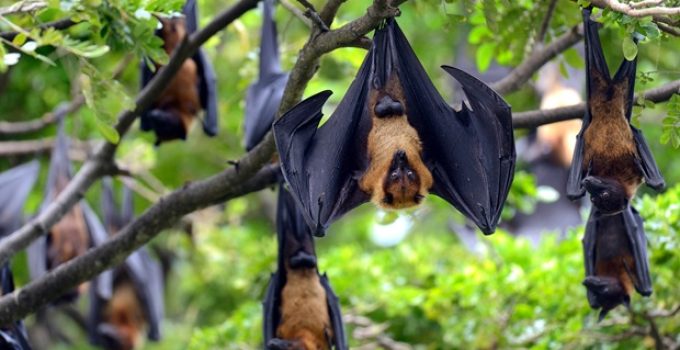Do Bats Live in Trees?
Yes, many bat species live in trees. While caves and attics often come to mind as typical bat habitats, a significant number of bats roost in trees—either year-round or seasonally. These tree-roosting bats use the natural structures of bark, cavities, foliage, and even hanging vines to find shelter, raise young, and hide from predators.
Dive Deeper
- Why Do Bats Live in Trees?
- Where in Trees Do Bats Roost?
- Which Bat Species Live in Trees?
- Tree Roosts vs. Caves: What’s the Difference?
- Threats to Tree-Roosting Bats
- 🎯 Final Thoughts
- 📚 References
🌲 Why Do Bats Live in Trees?
Trees offer bats several benefits:
- Protection from predators
- Thermal regulation through canopy cover
- Proximity to food sources such as insects or fruit
- Availability of maternal roosts for raising pups
Many bats that live in forests prefer trees because they provide numerous microhabitats. Some species even switch between tree roosts daily to avoid predators or parasites.
| 📈 Statistic: According to the U.S. Forest Service, over 40% of bat species in North America rely on forests as their primary habitat [1].
🌿 Where in Trees Do Bats Roost?
Tree-dwelling bats are incredibly adaptable and can be found roosting in several parts of a tree:
| Roost Type | Description |
|---|---|
| Tree hollows | Cavities in dead or dying trees offer shelter and warmth |
| Loose bark | Bats wedge between bark and trunk to hide |
| Leaf clusters | Some species cling to large leaves, especially in the tropics |
| Tree foliage | Bats hang upside down among leaves, camouflaged in greenery |
| Hollow limbs | Used by smaller bats for group roosting or solitary rest |
🦇 Which Bat Species Live in Trees?
Tree-roosting behavior is common across many continents and species. Some well-documented examples include:
- Eastern red bat (Lasiurus borealis) – roosts in foliage and mimics dead leaves
- Hoary bat (Lasiurus cinereus) – prefers coniferous trees, especially in North America
- Little yellow-shouldered bat (Sturnira lilium) – found in tropical forests of Central and South America
- Flying foxes (Pteropus spp.) – large fruit bats that roost in treetop colonies across Southeast Asia and Australia
| 🌍 Fun Fact: The hoary bat (Lasiurus cinereus), one of North America’s most widespread species, spends nearly its entire life in trees—even migrating and hibernating within forest canopies [2].
🏞️ Tree Roosts vs. Caves: What’s the Difference?
Both caves and trees offer shelter, but they differ in stability, temperature, and exposure.
| Feature | Tree Roosts | Cave Roosts |
|---|---|---|
| Temperature | Variable, can fluctuate with weather | Stable, especially deeper inside |
| Predator exposure | Higher, depending on foliage density | Lower, due to isolation and darkness |
| Roost stability | Often temporary or weather-dependent | Long-term and less disturbed |
| Species preference | Migratory and solitary bats | Colony-forming and hibernating bats |
Tree roosts are often used by solitary bats or small groups, while caves support large colonies.
🚫 Threats to Tree-Roosting Bats
Tree-roosting bats face growing threats due to:
- Deforestation and habitat fragmentation
- Tree removal during maternity season
- Pesticide use, reducing insect availability
- Climate change, altering roost temperatures and vegetation cycles
| ⚠️ Statistic: A 2021 study found that tree-roosting bats are more vulnerable to population declines than cave-dwelling species due to their dependence on specific roosting conditions and structures [3].
Conservation practices, such as preserving old trees, delaying tree cutting until after pup season, and installing bat boxes, help mitigate these risks.
🎯 Final Thoughts
Yes, bats do live in trees—and in fact, many species depend on them for daily survival, reproduction, and shelter. Trees provide a range of roosting options, from leafy foliage to hollow trunks. As deforestation continues to shrink forest habitats, understanding and protecting tree-roosting bats becomes increasingly vital to conserving biodiversity and supporting healthy ecosystems.
📚 References
- U.S. Forest Service. (2013). “Bats and Forests.” https://www.fs.usda.gov/
- Cryan, P. M. (2003). “Seasonal distribution of migratory tree bats (Lasiurus spp.) in North America.” Journal of Mammalogy, 84(2), 579–593. https://doi.org/10.1644/1545-1542(2003)084<0579:SDOMTB>2.0.CO;2
- Jung, K., et al. (2021). “Forest structure shapes roost selection and vulnerability in tropical tree-roosting bats.” Biological Conservation, 259, 109144. https://doi.org/10.1016/j.biocon.2021.109144
